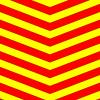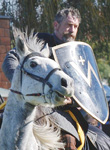 |
|
|
|
| Author |
Message |
Colin & Lynlee

Location: N Z & NSW
|
 Posted: Fri Sep 12, 2008 11:05 am What is traditional and period? Posted: Fri Sep 12, 2008 11:05 am What is traditional and period? |
 |
|
For those who are now looking at making more authentic garb, I thought I might add my thoughts and study here.
Traditionally made is NOT badly made.
People didn't have to make more than one or two new items per year and they put a lot of effort into what they did make, as it showed status and skill.
While a soldier or peasant may cobble together repairs, anybody with a wife/mother/sister to care for them actually had a good standard or sewing. With only a few garments you couldn't afford to have them fraying out on you. In all likelihood the only visible stitches were those intended to be seen. The Vikings often deliberately left the seams on the outside. This would have been both more comfortable to wear, and shout the skill of the seamstress. The landsknecht was originally a painfully poor soldier who recycled scraps of fabric from the battlefield into really bright and colourful garb. These were soldiers who spent down time honing sewing skills and creativity.
Fabric did not have to be coarse. As a spinner and weaver I know that it is very possible to make beautiful cloth with basic tools and a little effort.
Thick chunky wools etc were made this way for warmth and then properly "fulled"to bind the fibres together and add wind and water resistence. They would not normally have been allowed to fray into oblivion. If the fabric edge is not visible, you should not be able to see the stitches therefore machine sewn hidden seams are more visually authentic and rough ones which look like potato sacks and pull apart.
Likewise when you are sewing on emblems or the like, you should not see frayed edges or zigzag machine stitches, unless the garment is made in a hurry for a specific event (probably most garments made in NZ at this stage) or intended for rapid distruction like a target for the archers to use.
Colour was one thing even the very poor could afford, because it usually came from weeds. The peasant who made their own items had a better selection of colours than did later city dwelling paupers, so washed out dyes were a feature of industrialzed europe rather than medieval times. The predominance of black and brown in England was because Queen Victoria made the whole country go into mourning for Albert!
German excavations have showed silk imported by 400BC. Silk can be very finely woven because the silkworm does the spinning. It is turned into useable yarn by getting unwanted girl children to hold the cases in nearly boiling water until the gum melts and just unwinding it. No skill or finesse involved. Europe had it's own silk industry by Medieval times and fed the worms on Oak Leaves which make a slightly thicker thread and less even than the Mulberry used in Asia.
Hand spun yarn on a spindle was MUCH finer than on later spinning wheels. In Pre Roman times, Indian women could spin 500 000 yards from one pound of cotton. There is not a machine today which can do this. 7 layers of this cloth were still see through!!! Even in much later Dark Ages and Medieval Europe, fine gausy fabric was used by bee keepers as veils to keep out bees without restricting sight.
Fabrics were even as "slub" or uneven thread was only made by children or the stupid. The same for weaving. A simple Tabby weave can easily be produced evenly with little more than a couple of sticks, a backstrap and some thread. it might not be wide, but then it was joined at the edges to make larger items.
There is also not one "authentic" pattern for each garment. Each Tailor had their own patterns either given to them by their mentor at the end of the apprenticeship, or custom made for the needs of their master. The real test of authenticity is to see how much scrap material you have at the end. For early times and status below Royalty, there should not be much more than a handful per garment. More seams are more authentic due to both fabric width and expense. As many of us also like to maximize the money we spend, seams and slight mismatch of patterns (yes they did have patterns in both colour and weave) are a good thing.
I hope that is of some help to someone.
Lynlee
_________________
Where there is much desire to learn, there of necessity will be much arguing, much writing, many opinions; for opinions in good men is but knowledge in the making.
John Milton
English poet (1608 - 1674) |
|
|
 |
Kotek

Location: Christchurch, NZ
|
 Posted: Sat Sep 13, 2008 1:23 am Posted: Sat Sep 13, 2008 1:23 am |
 |
|
| Inflammatory statement goes here... |
|
|
 |
Colin & Lynlee

Location: N Z & NSW
|
 Posted: Sun Sep 14, 2008 12:43 pm What is authentic and period? Posted: Sun Sep 14, 2008 12:43 pm What is authentic and period? |
 |
|
Just thought that someone else may be interested to have a brief summary of my personal research of existing remains of authentic clothing.
At the Taupo joust 2007 a "tourist" told me nothing on display was authentic as "they did not have wheels or metal in medieval times". It all depends on what village we are talking about I suppose.
I can give the museum references if you are interested.
Lynlee 
_________________
Where there is much desire to learn, there of necessity will be much arguing, much writing, many opinions; for opinions in good men is but knowledge in the making.
John Milton
English poet (1608 - 1674) |
|
|
 |
pmel018
Principal Sponsor
Location: Wokingham, near Reading, UK
|
 Posted: Tue Sep 16, 2008 4:36 am Posted: Tue Sep 16, 2008 4:36 am |
 |
|
Hi Lynlee
what you say about traditional not meaning badly made issuch a great comment. It can be extended to all aspects of re-enactment from clothing to weapons, cooking gear to armour. Our ancestors would spend time, effort and resources on obtaining, or making, items that were the best they could manage. The idea the things were rough in 'them olden days' is one passed down by the Victorians and perpetuated by the entertainment media. Every time I see Robin of Sherwood replayed here in the UK I can feel re-eneactment move back about 10 years as someone takes it for reality.
Well said, 'tis to be hoped people will check out your research and make use of it
Phil |
|
|
 |
Wellybex

Location: Wellington
|
 Posted: Tue Sep 16, 2008 11:51 am Posted: Tue Sep 16, 2008 11:51 am |
 |
|
That was a great article!!
You most certainly wouldn't want to go to all that effort to make something to have it fall apart (much like my roughly thrown together 'OMG it's NAAMA next weekend and i need something to wear' dress). Unless you had a fair bit of money you wouldn't be able to afford to buy fabric like we do today, you would do everything from sctratch and you would do it well with the resources you had.
_________________
“You've been chasing me your entire life, only to fail now. I think that's the worst thing I've ever heard; how marvellous.” |
|
|
 |
stephan
|
 Posted: Fri Sep 19, 2008 12:23 pm Posted: Fri Sep 19, 2008 12:23 pm |
 |
|
love it
didnt have wheels...
whatever moron
didnt have metal
whats armour made of ? |
|
|
 |
Grizz

|
 Posted: Fri Sep 19, 2008 5:42 pm Posted: Fri Sep 19, 2008 5:42 pm |
 |
|
I saw a thick hand knitted woolen pullover when i was over in Gdansk .It was found in one of the dunnies that they were excavating in a 15th century building .It was just like something a westie would were today 
I was told that old dunnies are a good place to find well preserved textiles and leather items .It must be the tannins in the cack . |
|
|
 |
stephan
|
 Posted: Tue Oct 14, 2008 10:55 am Posted: Tue Oct 14, 2008 10:55 am |
 |
|
really
a heavy knitted pullover...
thats pretty cool i wonder if it was thrown down as a fashion satement |
|
|
 |
|
|
 Please read the terms of use
Please read the terms of use
 Contact the Site Admin
Contact the Site Admin

